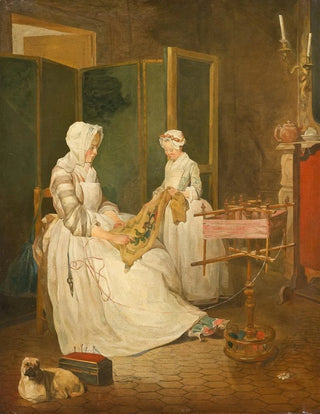Art print | The diligent mother - Jean Siméon Chardin


View from behind

Frame (optional)
In the panorama of art history, certain works transcend their era and still resonate with unparalleled emotional power. "La mère diligente" by Jean Siméon Chardin is one of these iconic creations. Painted in the 18th century, this striking artwork invites the viewer to delve into the intimacy of a domestic scene, where a mother's tenderness and a child's curiosity meet. Through this canvas, Chardin manages to capture the beauty of everyday life, transforming a mundane moment into a representation imbued with sensitivity and depth. The soft light illuminating the faces and objects in the painting creates a warm atmosphere, inviting serene and emotional contemplation.
Style and uniqueness of the work
Chardin's style is distinguished by its ability to combine realism and poetry. In "La mère diligente," he uses gentle colors and a subtle painting technique to bring to life characters who seem almost tangible. The composition is carefully balanced, with each element having its place in this domestic scene. The mother, focused on her task, embodies devotion and love, while the child, curious and attentive, symbolizes innocence and wonder. Chardin excels in depicting textures, whether of clothing, everyday objects, or facial expressions. This attention to detail, combined with natural light, gives the work an almost tactile dimension, allowing the viewer to feel the warmth of this family interaction. The apparent simplicity of the scene masks a psychological depth that challenges and touches every observer.
The artist and his influence
Jean Siméon Chardin, a major figure of the Rococo movement, knew how to mark his era with an innovative approach to genre painting. Originating from Paris, he was initially influenced by the great masters of the past but quickly developed a style that was uniquely his own, centered on daily life and domestic scenes. His works, often imbued with gentle melancholy, highlight human relationships and simple yet profound emotions underlying them. Chardin inspired many artists, both during his lifetime and after his death, by

Matte finish

View from behind

Frame (optional)
In the panorama of art history, certain works transcend their era and still resonate with unparalleled emotional power. "La mère diligente" by Jean Siméon Chardin is one of these iconic creations. Painted in the 18th century, this striking artwork invites the viewer to delve into the intimacy of a domestic scene, where a mother's tenderness and a child's curiosity meet. Through this canvas, Chardin manages to capture the beauty of everyday life, transforming a mundane moment into a representation imbued with sensitivity and depth. The soft light illuminating the faces and objects in the painting creates a warm atmosphere, inviting serene and emotional contemplation.
Style and uniqueness of the work
Chardin's style is distinguished by its ability to combine realism and poetry. In "La mère diligente," he uses gentle colors and a subtle painting technique to bring to life characters who seem almost tangible. The composition is carefully balanced, with each element having its place in this domestic scene. The mother, focused on her task, embodies devotion and love, while the child, curious and attentive, symbolizes innocence and wonder. Chardin excels in depicting textures, whether of clothing, everyday objects, or facial expressions. This attention to detail, combined with natural light, gives the work an almost tactile dimension, allowing the viewer to feel the warmth of this family interaction. The apparent simplicity of the scene masks a psychological depth that challenges and touches every observer.
The artist and his influence
Jean Siméon Chardin, a major figure of the Rococo movement, knew how to mark his era with an innovative approach to genre painting. Originating from Paris, he was initially influenced by the great masters of the past but quickly developed a style that was uniquely his own, centered on daily life and domestic scenes. His works, often imbued with gentle melancholy, highlight human relationships and simple yet profound emotions underlying them. Chardin inspired many artists, both during his lifetime and after his death, by






